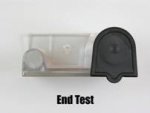Here are my numbers as of 20 minutes ago:
FC = 0
TC = 3 (This has dropped from >5 yesterday since I added the 5 pounds of ChlorBrite.)
pH = 6.8 (Down from 7.2 since yesterday.)
TA = 70 (Down from 80 since yesterday.)
CH = 470 (First measurement.)
CYA = 120 (to 210) Both interpolated, as the scale only goes to 100. It's certainly greater than 100.
It's a big observational swing, but I'm still working on the testing procedures. At 210 I was unable to see the edges of the black dot against light floor in a dim room, but we could see the bottom was dark. At 120 I was unable to see any dark at all in the bottom of the tube against our concrete apron outside in the light. We performed this test six times, as there was plenty of reagent remaining in the squeeze bottle for two complete tests for each of three refillings. Leslie's automated run gave us a "40" reading three days ago.
The trichlor puck machine has remained on "3," and I've added five pounds of ChlorBrite since yesterday in a misunderstood attempt to shock the pool.
The appearance is fine, clear and sparkling. It's three years old.
So, can the water be saved, or is this an open and shut "replace 67% of the water," as the Pool Calculator determined? I've armed myself with 12 bottles of Chlorox just in case the other numbers don't support our newbie interpretation of the CYA.
Thanks.
FC = 0
TC = 3 (This has dropped from >5 yesterday since I added the 5 pounds of ChlorBrite.)
pH = 6.8 (Down from 7.2 since yesterday.)
TA = 70 (Down from 80 since yesterday.)
CH = 470 (First measurement.)
CYA = 120 (to 210) Both interpolated, as the scale only goes to 100. It's certainly greater than 100.
It's a big observational swing, but I'm still working on the testing procedures. At 210 I was unable to see the edges of the black dot against light floor in a dim room, but we could see the bottom was dark. At 120 I was unable to see any dark at all in the bottom of the tube against our concrete apron outside in the light. We performed this test six times, as there was plenty of reagent remaining in the squeeze bottle for two complete tests for each of three refillings. Leslie's automated run gave us a "40" reading three days ago.
The trichlor puck machine has remained on "3," and I've added five pounds of ChlorBrite since yesterday in a misunderstood attempt to shock the pool.
The appearance is fine, clear and sparkling. It's three years old.
So, can the water be saved, or is this an open and shut "replace 67% of the water," as the Pool Calculator determined? I've armed myself with 12 bottles of Chlorox just in case the other numbers don't support our newbie interpretation of the CYA.
Thanks.


